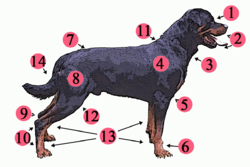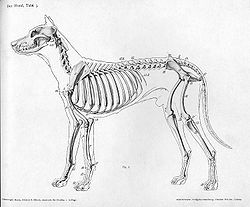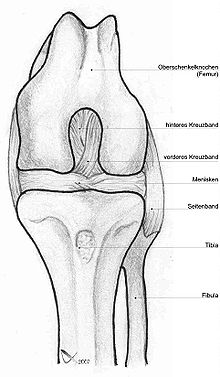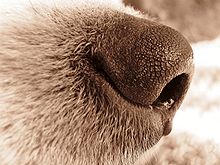- Dog anatomy
-
Dog anatomy includes the same internal structures that are in humans. Details of structures vary tremendously from breed to breed, more than in any other animal species, wild or domesticated,[1] as dogs vary from the tiny Chihuahua to the giant Irish Wolfhound.
Contents
Physical characteristics
Like most predatory mammals, the dog has powerful muscles, a cardiovascular system that supports both sprinting and endurance, and teeth for catching, holding, and tearing.
The dog's ancestral skeleton provided the ability to jump and leap. Their legs are designed to propel them forward rapidly, leaping as necessary, to chase and overcome prey. Consequently, they have small, tight feet, walking on their toes; their rear legs are fairly rigid and sturdy; the front legs are loose and flexible, with only muscle attaching them to the torso.
Although selective breeding has changed the appearance of many breeds, all dogs retain the basic ingredients from their distant ancestors. Dogs have disconnected shoulder bones (lacking the collar bone of the human skeleton) that allow a greater stride length for running and leaping. They walk on four toes, front and back, and have vestigial dewclaws on their front legs and sometimes on their rear legs.When a dog has extra dewclaws in addition to the usual one on each front leg, the dog is said to be "double dewclawed".
There is some debate about whether a dewclaw helps dogs to gain traction when they run because, in some dogs, the dewclaw makes contact when they are running and the nail on the dewclaw often wears down in the same way that the nails on their other toes do, from contact with the ground. However, in many dogs the dewclaws never make contact with the ground; in this case, the dewclaw's nail never wears away, and it is then often trimmed to keep it to a safe length.
The dewclaws are not dead appendages. They can be used to lightly grip bones and other items that dogs hold with the paws. However, in some dogs these claws may not appear to be connected to the leg at all except by a flap of skin; in such dogs the claws do not have a use for gripping as the claw can easily fold or turn. [2]
There is also some debate as to whether dewclaws should be surgically removed.[citation needed]The argument for removal states that dewclaws are a weak digit, barely attached to the leg, so that they can rip partway off or easily catch on something and break, which can be extremely painful and prone to infection. Others say the pain of removing a dewclaw is far greater than any other risk. For this reason, removal of dewclaws is illegal in many countries. There is, perhaps, an exception for hunting dogs, who can sometimes tear the dewclaw while running in overgrown vegetation. [3] If a dewclaw is to be removed, this should be done when the dog is a puppy, sometimes as young as 3 days old, though it can also be performed on older dogs if necessary (though the surgery may be more difficult then). The surgery is fairly straight-forward and may even be done with only local anesthetics if the digit is not well connected to the leg. Unfortunately many dogs can't resist licking at their sore paws following the surgery, so owners need to remain vigilant.
In addition, for those dogs whose dewclaws make contact with the ground when they run, it is possible that removing them could be a disadvantage for a dog's speed in running and changing of direction, particularly in performance dog sports such as dog agility.
The dog's ancestor was about the size of a Dingo, and its skeleton took about 10 months to mature. Today's toy breeds have skeletons that mature in only a few months, while giant breeds such as the Mastiffs take 16 to 18 months for the skeleton to mature. Dwarfism has affected the proportions of some breeds' skeletons, as in the Basset Hound.
Knowledge of basic anatomy also helps when competing in dog shows or contests.
Size
Researchers have identified a particular piece of genetic material that is common to every small-dog breed and, in turn, is probably responsible for making them tiny. The study, published in 2007, found a regulatory sequence (not a gene) next to the gene IGF1; together the gene and regulatory sequence together are known as a haplotype that "is a major contributor to body size in all small dogs." Medium and large size dogs do not usually have the regulatory sequence, although the small-size sequence was found in the Rottweiler breed. The study included 3,241 dogs from 143 breeds. The researchers concluded the genetic instructions to make dogs small must be at least 12,000 years old, and it is not found in wolves.[2] Another study has shown that lap dogs (small dogs) are among the oldest dog types.[3]
Modern dog breeds show more variation in size, appearance, and behavior than any other domestic animal. Within the range of extremes, dogs generally share attributes with their wild ancestors, the wolves. Dogs are predators and scavengers, possessing sharp teeth and strong jaws for attacking, holding, and tearing their food. Although selective breeding has changed the appearance of many breeds, all dogs retain basic traits from their distant ancestors. Like many other predatory mammals, the dog has powerful muscles, fused wristbones, a cardiovascular system that supports both sprinting and endurance, and teeth for catching and tearing.
Sight
Like most mammals, dogs are dichromats and have color vision equivalent to red-green color blindness in humans.[4][5][6] Different breeds of dogs have different eye shapes and dimensions, and they also have different retina configurations.[7] Dogs with long noses have a "visual streak" which runs across the width of the retina and gives them a very wide field of excellent vision, while those with short noses have an "area centralis" — a central patch with up to three times the density of nerve endings as the visual streak — giving them detailed sight much more like a human's.
Some breeds, particularly the sighthounds, have a field of vision up to 270° (compared to 180° for humans), although broad-headed breeds with short noses have a much narrower field of vision, as low as 180°.[4][5] ....
Hearing
Dogs detect sounds as low as the 16 to 20 Hz frequency range (compared to 20 to 70 Hz for humans) and above 45 kHz[8][9] (compared to 13 to 20 kHz for humans),[5]and in addition have a degree of ear mobility that helps them to rapidly pinpoint the exact location of a sound.[10] Eighteen or more muscles can tilt, rotate and raise or lower a dog's ear. Additionally, a dog can identify a sound's location much faster than a human can, as well as hear sounds up to four times the distance that humans are able to.[10] Those with more natural ear shapes, like those of wild canids like the fox, generally hear better than those with the floppier ears of many domesticated species.
Smell
Dogs have nearly 220 million smell-sensitive cells over an area about the size of a pocket handkerchief (compared to 5 million over an area the size of a postage stamp for humans).[12][13] According to nhm.org, dogs can sense odours at concentrations nearly 100 million times lower than humans can.[14] According to Dummies.com, the percentage of the dog's brain that is devoted to analyzing smells is actually 40 times larger than that of a human.[12] Some dog breeds have been selectively bred for excellence in detecting scents, even compared to their canine brethren.
Coat
Main article: Coat (dog)Domestic dogs often display the remnants of counter-shading, a common natural camouflage pattern. The general theory of countershading is that an animal that is lit from above will appear lighter on its upper half and darker on its lower half where it will usually be in its own shade.[15][16] This is a pattern that predators can learn to watch for. A countershaded animal will have dark coloring on its upper surfaces and light coloring below.[15] This reduces the general visibility of the animal. One reminder of this pattern is that many breeds will have the occasional "blaze", stripe, or "star" of white fur on their chest or undersides.[16]
Dogs diverged from a now-extinct Asian wolf between 12,000 and 15,000 years ago, according to recent DNA studies. In that time, the long nose and heavy grey-colored double coat of the wolf has changed into the wide variety of dog shapes and coats and colors seen today. The change was due at first to genetic changes that occurred as the original dogs learned to tolerate the presence of humans, as shown in the research on foxes by Dmitri Belyaev in his Farm-Fox Experiment. The research found that a genetic change to tameness brought along other unexpected changes as well; one notable change was in the coats, changed from a typical fox coat to a spotted coat resembling a dog's coat. As ancient dogs learned to live near humans and became less like wolves, their appearance changed as well, long before any selective breeding was done by people.[17]
A Stanford University School of Medicine study published in Science in October, 2007 found the genetics that explain coat colors in other mammals such as in horse coats and in cat coats, did not apply to dogs.[18] The project took samples from 38 different breeds to find the gene (a beta defensin gene) responsible for dog coat color. One version produces yellow dogs, and a mutation produces black. All dog coat colors are modifications of black or yellow.[19] For example, the white in white miniature schnauzers is a cream color, not albinism (a genotype of e/e at MC1R.)
Modern dog breeds exhibit a diverse array of fur coats, including dogs without fur, such as the Mexican Hairless Dog. Dog coats vary in texture, color, and markings, and a specialized vocabulary has evolved to describe each characteristic.[20]
Tail
There are many different shapes for dog tails: straight, straight up, sickle, curled, cork-screw. In some breeds, the tail is traditionally docked to avoid injuries (especially for hunting dogs).[21] It can happen that some puppies are born with a short tail or no tail in some breeds.[22]
Puppy characteristics
Puppies often have characteristics that do not last beyond early puppyhood. Eye color often changes from blue to its adult color as the puppy matures. The coat color may change: Kerry Blue Terrier puppies have black coats at birth and change to blue with maturity, and Dalmatians are white and gain their spots with age. The ear shape will also often change, especially with erect-eared breeds such as the German Shepherd Dog which have soft ears at birth, but the cartilage strengthens with age. Labrador Retrievers and other swimming dogs start off with a very fluffy puppy coat, and over time the water proof layer grows. Puppies that are going to grow into larger dogs will often have over sized paws to begin with, and then the rest of them grow to fit.
Temperature regulation
It is a common misconception that dogs do not sweat[dubious ]. They do sweat, mainly through the footpads, but only a small fraction of a dog's excess heat is lost this way. Primarily, dogs regulate their body temperature through panting.[23] Panting moves cooling air over the moist surfaces of the tongue and lungs, rejecting heat to the atmosphere.
Dogs possess a rete mirabile, a complex of intermingled small arteries and veins, in the carotid sinus at the base of their neck. This acts to thermally isolate the head, which contains the brain, the most temperature-sensitive organ, from the body, which contains the muscles, where most of the heat is generated. The result is that dogs can sustain intense physical exertion over a prolonged time in a hot environment, compared to animals which lack this apparatus; thus, a dog chasing a jackrabbit through the desert may not be able to outrun the rabbit, but it can continue the chase until the rabbit slows due to overheating.
See also
References
- ^ Scientists fetch useful information from dog genome publications, Cold Spring Harbor Laboratory, December 7, 2005; published online in Bio-Medicine quote: "Phenotypic variation among dog breeds, whether it be in size, shape, or behavior, is greater than for any other animal"
- ^ "Why Small Dogs Are Small: Ancient Genetic Material Keeps Pups Pint-Sized". University of Utah news Center. University of Utah. April 5, 2007. http://www.unews.utah.edu/p/?r=032807-6. Retrieved 08/09 2008. which is a precis of
Sutter NB, Bustamante CD, Chase K, et al. (Apr 2007). "A single IGF1 allele is a major determinant of small size in dogs". Science 316 (5821): 112–5. doi:10.1126/science.1137045. PMC 2789551. PMID 17412960. http://www.pubmedcentral.nih.gov/articlerender.fcgi?tool=pmcentrez&artid=2789551. - ^ Ostrander EA (Sep-Oct 2007). "Genetics and the Shape of Dogs; Studying the new sequence of the canine genome shows how tiny genetic changes can create enormous variation within a single species". Am Sci.. http://www.americanscientist.org/issues/feature/2007/5/genetics-and-the-shape-of-dogs.
- ^ a b Arts and Entertainment Network (1998). Big Dogs Little Dogs: The World of Our Canine Companions. GT Publishing Corporation. ISBN 1-57719-353-9. — companion volume to the A&E special presentation
- ^ a b c Alderton, David (1984). Dog: The Most Complete, Illustrated, Practical Guide to Dogs and Their World. Book Sales. ISBN 0-89009-786-0.
- ^ Davis Jennifer (1998). "Dr. P's Dog Training: Vision in Dogs & People". http://www.uwsp.edu/psych/dog/LA/davis2.htm. Retrieved 2008-06-06.
- ^ Jonica Newby, Caroline Penry-Davey (2003-09-25). "Catalyst: Dogs' Eyes". Australian Broadcasting Corporation. http://www.abc.net.au/catalyst/stories/s953902.htm. Retrieved 2006-11-26.
- ^ "How well do dogs and other animals hear". http://www.lsu.edu/deafness/HearingRange.html.
- ^ Elert, Glenn; Timothy Condon (2003). "Frequency Range of Dog Hearing". The Physics Factbook. http://hypertextbook.com/facts/2003/TimCondon.shtml. Retrieved 2008-10-22.
- ^ a b "Dog Sense of Hearing". seefido.com. http://www.seefido.com/html/dog_sense_of_hearing.htm. Retrieved 2008-10-22.
- ^ "How Good is a Dog's Sense of Smell?". peteducation.com. http://www.peteducation.com/article.cfm?c=2+1553&aid=1098. Retrieved 2008-10-22.
- ^ a b "Understanding a Dog's Sense of Smell". Dummies.com. http://www.dummies.com/WileyCDA/DummiesArticle/id-5324.html. Retrieved 2008-10-22.
- ^ "The Dog’s Sense of" (PDF). Alabama and Auburn Universities. http://www.aces.edu/pubs/docs/U/UNP-0066/UNP-0066.pdf. Retrieved 2008-10-22.
- ^ "Smell". nhm.org. 6 May 2004. Archived from the original on 2008-08-01. http://web.archive.org/web/20080801101136/http://www.nhm.org/exhibitions/dogs/formfunction/smell.html. Retrieved 2008-10-22.
- ^ a b Klappenbach, Laura (2008). "What is Counter Shading?". About.com. http://animals.about.com/od/zoology12/f/countershading.htm. Retrieved 2008-10-22.
- ^ a b Cunliffe, Juliette (2004). "Coat Types, Colours and Markings". The Encyclopedia of Dog Breeds. Paragon Publishing. pp. 20–3. ISBN 0752565613.
- ^ Trut, Lyudmila N (1999). "Early Canid Domestication: The Farm-Fox Experiment". American Scientist 87 (2): 160–9. http://www.floridalupine.org/publications/PDF/trut-fox-study.pdf.. (A Russian study of pedomorphosis in a 40-year breeding program to domesticate red foxes.)
- ^ Candille SI, Kaelin CB, Cattanach BM, et al. (Nov 2007). "A -defensin mutation causes black coat color in domestic dogs". Science 318 (5855): 1418–23. doi:10.1126/science.1147880. PMC 2906624. PMID 17947548. http://www.pubmedcentral.nih.gov/articlerender.fcgi?tool=pmcentrez&artid=2906624.
- ^ Stanford University Medical Center, Greg Barsh et al. (2007, October 31). Genetics Of Coat Color In Dogs May Help Explain Human Stress And Weight. ScienceDaily. Retrieved September 29, 2008
- ^ "Genetics of Coat Color and Type in Dogs". Sheila M. Schmutz, Ph.D., Professor, University of Saskatchewan. October 25, 2008. http://homepage.usask.ca/~schmutz/dogcolors.html. Retrieved 11/05 2008.
- ^ "The Case for Tail Docking". cdb.org. http://www.cdb.org/case4dock.htm. Retrieved 2008-10-22.
- ^ "Bourbonnais pointer or ‘short tail pointer’". http://www.braquedubourbonnais.info/en/tail-genetics.htm.
- ^ http://www.petplace.com/dogs/how-do-dogs-sweat/page1.aspx
External links
Dogs Training Behavior Health Types List of types · Bandogs · Eskimo dogs · Companion dog · Curs · Fighting dogs · Guard dogs · Herding dogs · Hounds · Hunting dogs · Bird dogs · Gun dogs · Lap dogs · Livestock guardian dogs · Mountain dog · Pointers · Retrievers · Setters · Primitive dogs · Scenthounds · Sighthounds · Sled dogs · Terriers · Turnspit dogs · Water dogsBreeds Work Human–dog
interactionAnimal testing · Baiting · Breed-specific legislation · Communication · Dog park · Dog sports · Dog walking · Dog daycare · Dog grooming · Intelligence · Therapy · Training · Fear of dogs · Dog license · Dog food · Dogs in religionCategory · Portal · BookCategories:- Dog anatomy
- Dog shows and showing
Wikimedia Foundation. 2010.







